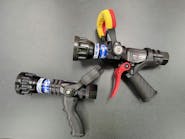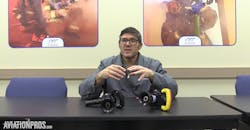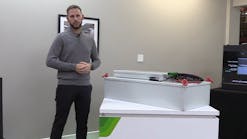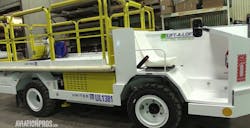Fuel tanks at major airports can range in size from 300,000 to three million gallons, with a height up to 50 feet. The abatement of lead-based paint from such tanks is a very labor-intensive process. In the past it has been accomplished by installation of conventional construction scaffolding around the entire tank and enclosing either portions of the scaffolding or the entire scaffolding system in plastic sheeting fastened to the tank, to create an enclosed space within which the workers remove lead-based paint with scrapers. The paint particles fall to the bottom of the plastic enclosure, where they are vacuumed up at the end of each shift and stored as hazardous waste, awaiting shipment off site.
The most common method for repainting steel bridge structures involves removing the existing lead-based paint coatings with open abrasive blasting. This method creates hazardous air concentrations of lead, other heavy metals, and when silica abrasives are used, silica. Currently contractors are required by regulations to contain paint chips, dust, and waste abrasive materials during paint removal, typically with mesh tarpaulins or rigid structures, to protect the environment.
Unfortunately, the containment structures which control environmental emissions often increase workers’ risks of hazardous exposures to lead and other materials by concentrating these agents.
EWR’s bulk fuel farm
At Newark Liberty International Airport (EWR) the bulk fuel farm has a total of 27 jet fuel tanks with an aggregate fuel storage capacity of 16.5 million gallons. Twenty four of the jet fuel tanks were constructed in the mid-1970s, and they include a red oxide primer coat under two coats of white lead-based paint.
Contractors used conventional scaffolding and manual scraping methods for spot removal of lead-based paint on several tanks in 2007 and 2008. The project took much longer than anticipated due to low productivity.
An improved method of removing lead-based paint from the jet fuel tanks was developed and demonstrated on six 369,000-gallon jet fuel tanks in 2009. These tanks are 42 feet in diameter and 40 feet high, and are located within annular dikes which are 88 feet in diameter. Photo 1 indicates a typical configuration of a typical tank, within its annular containment dike plus the spiral tank-top access ladder.
During windy or rainy days, it is exceedingly difficult to maintain the shrouded plastic enclosure over the scaffolding sufficiently tight enough to contain all small lead-based paint particles (dust and flakes) within the enclosure. Leakage of such particles outside the controlled workspace can lead to potential violations of OSHA limitations for airborne lead dust in the workplace.
In addition, fixed construction scaffolding typically has floor planking height adjustments of two feet which do not allow the paint removal operators to use their equipment at proper ergonomic height over the entire height of the tank. This can lead to operator repetitive stress injuries or decreased productivity.
The project team focused on sourcing equipment to remove the two main impediments in the previous method of lead based paint removal, namely:
- Establishing and maintaining a means of capturing all dust particles removed from the tank surface; and
- Providing a stable, OSHA-approved motorized work platform that could travel vertically up the side of the tank shell from grade to the top of the tank and allow two workers to strip paint from an area of the tank up to 12 feet while under optimum ergonomic conditions.
Capturing lead particles
Elimination of the plastic sheeting enclosure was achieved by the use of vacuum-assisted paint removal equipment, wherein the paint is abraded by a pneumatically driven shrouded mechanical tool which has a vacuum hose connection to a central vacuum system with a HEPA filter.
Photo 2 illustrates a shrouded drum sander with tungsten carbide abrasive elements. Typically the drum sander is used for large open areas of paint removal and the needle gun is used for complex shapes where the drum sander will not fit. The shroud is connected to the central vacuum system to ensure that all paint dust and particles are captured and not released to the environment.
The central vacuum system extracts paint particles from the removal tools into a sealed 55-gallon drum; the exhaust from the vacuum system is passed through a series of HEPA filters to ensure that no airborne lead dust is contained in the exhaust stream. The vacuum unit used at EWR was capable of operating a maximum of six removal tools simultaneously.
When a 55-gallon drum is full of paint particles, typically at the end of a shift, the equipment is shut down and the drum is sealed and removed from the central vacuum system and replaced with an empty drum. It’s then disposed of as hazardous material by a licensed hauler. A third party monitoring firm was used to confirm that air quality in and adjacent to the working area was less than the OSHA mandated Action Level of 30 µg/m3. The permissible exposure level (PEL) for an eight-hour day is 50 µg/m3.
Waste lead and lead-containing residues (such as dust from vacuuming) may be designated hazardous wastes, as defined in 40 CFR 261, and special handling and worker training may be required under applicable sections of 40 CFR 262 through 268. Furthermore, releases of reportable quantities of lead-containing wastes or compounds require reporting in accordance with 40 CFR 302.
A stable work platform
The search for a motorized work platform to raise a two-man crew up the side of the tank, with the required paint stripping tools, always being operated from ergonomically correct positions indicated that the following equipment configurations were available:
- motorized scissor lifts operating within the tank dike area;
- motorized boom lifts of various configurations and sizes operating over the tank dike wall.
- a cable-operated work platform suspended from the tank roof (i.e., a window washing platform); and
- a newly developed modular mast supported work platform system.
A review of the technical specification for the latter item indicated that it was the optimum choice for the large unobstructed areas of the tank, while a small boom lift or a scissors lift can be used around the spiral tank stairs, or obstructions caused by tank appurtenances.
The modular mast-supported work platform system is depicted in Photo 3, installed on the side of a 369,000-gallon tank at EWR. The lift platform is 13’-6” long x 3’-3” ft high x 2’-4” ft wide (interior).This unit has a safe working load of 2,000 pounds (uniformly distributed), which is well in excess of the loads imposed by two workers.
The leveling base of the support column is shown in Photo 4. In order to provide adequate lateral stability to the lift support columns, they must be attached to the tank near the top, bottom, and midpoints. Since jet fuel tanks are full of fuel, it was not possible to weld connection points onto the tanks to link the lift columns to the tank.
An alternate method of attachment was developed. It utilizes a high strength structural epoxy to install stainless steel “cleats” to the tank shell at the correct elevation and circumferential location for each lift column. These locations are marked out with a laser, and a boom lift is used to allow the paint removal contractor to remove all paint from the tank shell where the next cleat is to be glued to the shell with structural epoxy.
The great advantage of this type of lift is that it provides a very stable OSHA-approved work platform which can be traversed from the top of the tank down to grade, producing a 12-foot wide vertical swath of stripped paint from the top to the bottom of the tank shell. Set-up and relocation of this lift system can be performed by a two man crew with no requirement for overhead lifts or a crane.
Two complete lift sets were used for the abatement aspects of this project, and one boom lift was used for abatement of the cleat attachment areas, plus areas adjacent to the spiral tank stairs and also for priming and painting the abated tank shells.
The pilot project at EWR which was completed in December 2009 involving the six fuel tanks described above indicates that a two-man lead abatement crew can remove up to 500 square feet of lead-based paint per day resulting in a 369,000 gallon tank (40 feet high x 12 feet wide) being abated and repainted in ten working days.
With two lifts and two crews, a tank could be abated in five working days. This is a great improvement over the previous approach which used a four-man abatement crew up to a month per tank for spot abatement only, rather than total abatement. A test is being conducted to determine the feasibility of connecting the scaffolding system to the steel tank using a system of cam-actuated permanent magnets. This would remove the requirement to install stainless steel cleats on each tank and allow for a quicker and more cost-effective installation of the work platform system to each tank.





